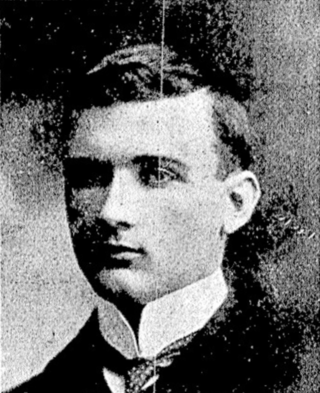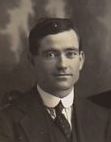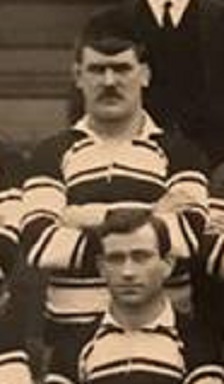Related Research Articles

The Fartown Ground or just simply Fartown is a sports ground located in the Huddersfield suburb of Fartown in West Yorkshire, England and is predominantly famous for being the home ground of Huddersfield Rugby League Club from 1878 to 1992. The grounds consisted of a rugby ground, a cricket ground used by Yorkshire County Cricket Club, Bowling greens and a running track as well as a pavilion. It was the scene of many great games, including the Challenge Cup finals of 1908 and 1910, several Challenge Cup semi finals, John Player Cup finals and international matches.

Douglas "Duggy" Clark MM was an English rugby league footballer, wrestler and World War I veteran. A Rugby Football League Hall of Fame inductee, he played for Huddersfield, Cumberland, England and the Great Britain national side, as a forward. Clarke helped Huddersfield to three Challenge Cups and seven Yorkshire Cups, and is in the club's Hall of Fame.
Alfred James Croston was an English rugby union, and professional rugby league footballer who played in the 1930s and 1940s, and coached rugby league in the 1940s and 1950s. He played representative level rugby union (RU) for Hampshire, at military level for Army Rugby Union, and the 38th Field Company Royal Engineers, and at club level for United Services Portsmouth, and representative level rugby league (RL) for Great Britain, England and Lancashire, and at club level for Castleford and Wakefield Trinity (captain), as a centre, and coached at club level for Wakefield Trinity.
William Holder was an English rugby union, and professional rugby league footballer who played in the 1900s and 1910s. He played club level rugby union (RU) for Gloucester RFC, and representative level rugby league (RL) for Great Britain and England, and at club level for Hull F.C., as a forward.
William Ward was an English professional rugby league footballer who played in the 1900s, 1910s and 1920s. He played at representative level for Great Britain and England, and at club level for Whitehaven, Egremont and Leeds, as a forward.

Frederick "Fred" Webster was an English professional rugby league footballer who played in the 1900s and 1910s. He played at representative level for Great Britain, England and Yorkshire, and at club level for Brotherton ARLFC, and Leeds (captain), as a forward.

Frank 'Bucket' H. Young was a Welsh rugby union, and professional rugby league footballer who played in the 1900s and 1910s. He played representative level rugby union (RU) for Glamorgan, and at club level for Cardiff RFC, London Welsh RFC and Bristol Rugby, and representative level rugby league (RL) for Great Britain and Wales, and at club level for Leeds, as a fullback.
Samuel William Jarman was an English professional rugby league footballer who played in the 1900s and 1910s. He played at representative level for Great Britain, and at club level for Leeds, as a fullback, or forward.
William Henry "Harry" Taylor was an English professional rugby league footballer who played in the 1890s, 1900s and 1910s. He played at representative level for Great Britain (captain), England and Yorkshire, and at club level for Hull F.C., as a fullback, making his début in the 5–10 away defeat by Bradford on Saturday 1 January 1898, and was captain of Hull during the 1902–03, 1903–04, 1907–08 and 1908–09 seasons, and coached at club level for Hull.

John Henry Rogers was a Welsh rugby union and professional rugby league footballer who played in the 1900s, 1910s and 1920s. He played club level rugby union (RU) for Bridgend RFC and Cardiff RFC, initially as a wing and later as a scrum-half and representative level rugby league (RL) for Great Britain, Wales and Other Nationalities, and at club level for Huddersfield and Wakefield Trinity, as a wing, stand-off, or scrum-half.
Frederick "Fred" Harrison was an English professional rugby league footballer who played in the 1910s. He played at representative level for Great Britain and England, and at club level for Leeds, as a forward.
The 1909–10 Northern Rugby Football Union season was the 15th season of rugby league football.
William Thomas Osborne was a Welsh international rugby forward who played rugby union for Mountain Ash and Glamorgan Police. Osborne played in six international matches, becoming a Triple Crown winner when he played for Wales in all three matches of the 1902 Home Nations Championship. At the height of his international career he 'Went North', switching to professional rugby league, and represented both Huddersfield and Hull FC.

Harold Francis Rowe was a New Zealand rugby footballer who was part of the professional 1907–08 New Zealand rugby tour of Australia and Great Britain.
Henry Wallace was an English professional rugby league footballer who played in the 1900s and 1910s. He played at representative level for England and Yorkshire, and at club level for Hull F.C., as a stand-off, or scrum-half. Harry Wallace served as Private with the 10th Battalion of the Durham Light Infantry in World War I, and died in service at Arras, France, leaving behind a widow and five children.

James Devereux (1887–1934), also known by the nickname of "Muscles", was a pioneering Australian rugby league footballer who played in the 1900s, 1910s and 1920s. As New South Wales state and Australia national representative three-quarter back, he played in the New South Wales Rugby Football League premiership from its first season in 1908 for the North Sydney club, before playing several seasons in England with Hull FC. He later returned to Australia and coached North Sydney.
Andy Morton (1882-1950) was a pioneering Australian rugby league footballer who played in the 1900s and 1910s. An Australia international and New South Wales state representative backline player, he played club football for North Sydney and in England for Hull FC.
The 1909–10 Challenge Cup was the 14th staging of rugby league's oldest knockout competition, the Challenge Cup.

Thomas Herridge was an English professional rugby league footballer who played in the 1900s, 1910s and 1920s, and professional boxer of the 1900s. He played at representative level for Yorkshire, and at club level for York and Hull F.C., as a forward.
George Thomas Cottrell, also known by the nickname of "Rocky", was an English rugby union and professional rugby league footballer who played in the 1900s and 1910s. He played representative level rugby union (RU) for Gloucestershire and at club level for Cheltenham All Saints RFC and Cheltenham RFC, as a full-back, or centre, and club level rugby league (RL) for Halifax RLFC, Hull FC and Keighley, as a wing, or centre.
References
- ↑ "A complete history of Hull FC's Challenge Cup finals". Hull Daily Mail. 22 August 2013. Archived from the original on 3 February 2014. Retrieved 1 January 2014.